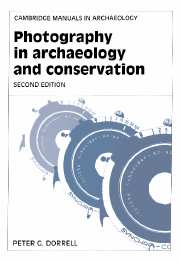Book contents
- Frontmatter
- Contents
- List of illustrations
- Preface
- Preface to the second edition
- Acknowledgements
- 1 The early days of archaeological photography
- 2 Basic principles and practice
- 3 Equipment
- 4 Lighting by flash
- 5 Photographic materials, processing and printing
- 6 Architecture and standing monuments
- 7 Survey photography
- 8 Site photography
- 9 Principles of object photography
- 10 Principles of close-up photography
- 11 Ultra-violet and infra-red photography
- 12 Photographing finds
- 13 Flat copy
- 14 Preparation of material for publication
- 15 The future
- References
- Index
2 - Basic principles and practice
Published online by Cambridge University Press: 23 December 2009
- Frontmatter
- Contents
- List of illustrations
- Preface
- Preface to the second edition
- Acknowledgements
- 1 The early days of archaeological photography
- 2 Basic principles and practice
- 3 Equipment
- 4 Lighting by flash
- 5 Photographic materials, processing and printing
- 6 Architecture and standing monuments
- 7 Survey photography
- 8 Site photography
- 9 Principles of object photography
- 10 Principles of close-up photography
- 11 Ultra-violet and infra-red photography
- 12 Photographing finds
- 13 Flat copy
- 14 Preparation of material for publication
- 15 The future
- References
- Index
Summary
A book of this nature must assume a certain knowledge of the basic principles of photography. There are many reliable books that can be consulted (Langford (1986) is one of the most comprehensive), and all that is attempted in this chapter is a resumé of the terms and concepts most often used, and a brief explanation of how the principles are applied in archaeological photography.
Forming an image
Visible light, the section of the electromagnetic spectrum from about 400 to 700 nanometres (1 nanometre, nm, = 10−9 metres, or one-millionth of a millimetre) that is reflected from an object or scene, can be focussed through a lens by ‘bending’ or refraction of the light rays to form a sharp image behind the lens. Sections of the total spectrum of wavelengths shorter or longer than visible light can also be recorded photographically by the special techniques of ultra-violet and infra-red photography.
Light reflected from a very distant object – more or less at infinity – will reach the lens as parallel beams, and the distance between the lens and the point at which such light is focussed constitutes the focal length of the lens. This is always expressed in millimetres. Since the focal length of a lens determines the size of the image, i.e. for an object the same distance away from the lens a long focal length lens will give a larger image than one of short focal length, it also determines the angle of view, the amount of the scene in front of the camera taken in by the lens.
- Type
- Chapter
- Information
- Photography in Archaeology and Conservation , pp. 8 - 19Publisher: Cambridge University PressPrint publication year: 1994



